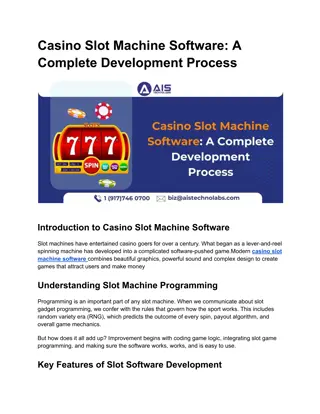
Runtime Analysis and Big O Notation Explained
Explore the concept of runtime analysis and Big O notation in algorithms, focusing on determining the resources required by algorithms such as time. Delve into examples, comparisons of program efficiency, and definitions of Big-Oh and Big-Omega notations.
Download Presentation

Please find below an Image/Link to download the presentation.
The content on the website is provided AS IS for your information and personal use only. It may not be sold, licensed, or shared on other websites without obtaining consent from the author. If you encounter any issues during the download, it is possible that the publisher has removed the file from their server.
You are allowed to download the files provided on this website for personal or commercial use, subject to the condition that they are used lawfully. All files are the property of their respective owners.
The content on the website is provided AS IS for your information and personal use only. It may not be sold, licensed, or shared on other websites without obtaining consent from the author.
E N D
Presentation Transcript
Cosc 2030 Run time analyst and Big O
Introduction Once an algorithm is given for a problem (and decided to be correct), it is important to determine how much in the way of resources, such as time or space, that the algorithm will require. We focus mainly on time in this course. Such an analysis will often allow us to improve our algorithms.
Running Time Analysis N Data Items 1000101010100011111000110001110101010101010101 0010001010101000100000000000011110101000111010 0010101010101010101010101111111100000011001011 Returns in time T1(N) Algorithm 1 N Data Items 1000101010100011111000110001110101010101010101 0010001010101000100000000000011110101000111010 0010101010101010101010101111111100000011001011 Returns in time T2(N) Algorithm 2
Analysis of Running Time (which program is better?) Running Time Program 1 Program 2 Number of Input Items
Example int foo1 (int a, int N) { int i, temp; int foo2 (int a, int N) { if (N == 1) return(a); else return(foo2(a, N/2) * foo2(a, N/2)); } temp = 1; for (i = 1; i <= N; i++) { temp = a*temp; } return(temp); } What do these two programs do? Do they compute the same thing? If so, which program is more efficient? Or are they equally efficient?
Big-Oh Notation: Definition: = ( ) ( ( if )) positive are there c f(N) T(N) constants N T N O f N and c such that when n n 0 0 This says that function T(N) grows at a rate no faster than f(N); thus f(N) is an upper bound on T(N).
Big-Oh Upper Bound Running Time T(N) f(N) T(N) n 0 Number of Input Items N
Big-Omega Notation Definition: = ( ) ( ( if )) positive are there c f(N) T(N) constants N T N f N and c such that when n n 0 0 This says that function T(N) grows at a rate no slower than f(N); thus f(N) is a lower bound on T(N).
Big-Omega Lower Bound Running Time T(N) T(N) f(N) n 0 Number of Input Items N
Big O functions. Big O Notation Name Example(s) Odd or Even number, Look-up table (on average) O(1) Constant O(log n) Logarithmic Finding element on sorted array with binary search Find max element in unsorted array, Duplicate elements in array with Hash Map O(n) Linear O(n log n) Linearithmic Sorting elements in array with merge sort Duplicate elements in array **(na ve)**, Sorting array with bubble sort O(n2) Quadratic O(n3) Cubic 3 variables equation solver O(2n) Exponential Find all subsets O(n!) Factorial Find all permutations of a given set/string
A Hierarchy of Growth Rates 2 k log log log log c N N 3 N N N N 2 3 N N N 2 ! N N N N
General Rules: For Loops The running time of a for loop is at most the running time of the statements inside the for loop (including tests) times the number of iterations. for (int i = 1; i <= N; i++) { sum = sum+i; } The above example is O(N).
General Rules: Nested Loops Analyze these inside out. The total running time of a statement inside a group of nested loops is the running time of the statement multiplied by the product of the sizes of all the loops. for (int i = 1; i <= N; i++) { for (int j = 1; j <= M; j++) { sum = sum+i+j; } } The above example is O(MN).
General Rules: Consecutive Statements Consecutive statements: These just add (which means that the maximum is the one that counts). for (int i = 1; i <= N; i++) { sum = sum+i; } for (int i = 1; i <= N; i++) { for (int j = 1; j <= N; j++) { sum = sum+i+j; } } The above example is O(N2+N) = O(N2).
General Rules: Conditionals If (test) s1 else s2: The running time is never more than the running time of the test plus the larger of the running times of s1 and s2. if (test == 1) { for (int i = 1; i <= N; i++) { sum = sum+i; }} else for (int i = 1; i <= N; i++) { for (int j = 1; j <= N; j++) { sum = sum+i+j; }} The above example is O(N2).
Symbol Balancing A useful tool for checking your code is to see if the (), {}, and [] symbols balance properly. For example the sequence [ ( ) ] is legal but the sequence [ ( ] ) is not. The presence of one misplaced symbol can result in hundreds of worthless compiler diagnostic errors!
Symbol Balancing Algorithm The algorithm is simple and efficient O(N): Make an empty stack. Read characters until end of file (EOF). If the character is an opening symbol ([{, push it onto the stack. If it is a closing symbol )]}, then if the stack is empty report an error. Otherwise pop the stack. If the symbol popped is not the corresponding opening symbol, report an error. At EOF, if the stack is not empty report an error.
Linked lists. We already know there are slow. But how do they rank in O(?) We insert into the front of the list The operation is three steps 1. get new node object with data 2. change next pointer to where head points 3. change head to point to the node
Linked lists (2) how about find? It looked something like this in code: for (temp = head; temp != nullptr; temp = temp->next) if (temp->data == item) return true or pointer to item depends on what is needed. return false or nullptr O( ? )
Linked lists (3) delete? O( ? ) insert last no tail pointer? insert last with a tail pointer? delete last?
Linked lists (3) How about double linked lists? Does it change the Big O ? So how about efficiently questions? is Double linked lists faster or slower then single linked lists?
Stacks and Queues For the STLs these are the required times. stacks insert O(1) delete O(1) Queues insert O(1) delete O(1) search O(n) search O(n)
Binary Search Algorithm int a[N]; // Sorted array int x; // Value to be found Time Units to Compute ------------------------------- 1 for comparison. int find (int left, int right) { if (left > right) return 1; int mid = (left+right) / 2; if (x < a[mid]) bin_search(left, mid-1); else if (x > a[mid]) bin_search(mid+1,right); else return mid; } 1 for computation of mid. 1 for comparison. T(N/2) 1 for comparison. T(N/2) Thus T(N) = T(N/2) + 4.
Solution = + ( ) = ( ) 2 / 4 T N T N Some math, a series for those interested ) 1 ( T 1 = + = ) 2 ( T 1 4 5 = + = ) 4 ( T 5 4 9 = + = ) 8 ( T 9 4 13 = = + = k If 2 + , ( O ) 4 N 1 N T = N k 4 log 1 (log ) N
General Observation If an algorithm takes constant O(1) time to cut the problem size by a fraction (usually ), then the algorithm is O(log2N). For binary search we halve the search space each time we call the function. Thus binary search is O(log2N). Generally speaking, most Divide and Conquer algorithms are O(log2N) or O(Nlog2N) because they loop around it.
Binary Search Trees BinaryNode *find (T x, BinaryNode<T> *t) { if ( t == nullptr ) return nullptr; else if ( x < t data ) return find ( x, t else if ( t data < x ) return find ( x, t else return t; // Match } So with Binary search trees We have a O( ? ) left ); And our dictionary algorithm We have N number of words O( ? ) right );
Binary Search Trees (2) void insert (T x, BinaryNode<T> *&t) { if (t == nullptr) t = new BinaryNode<T> (x); else if (x < t data) insert(x, t left); else if( t data < x) insert(x, t right); else ; // Duplicate entry; do nothing } So the insert would O(log2N) as well.
Binary Search Trees So how about print in postfix order postorderTravsal(BinaryNode<dtype> * t) { if (t == nullptr) return; else { postorderTravsal(t->left); postorderTravsal(t->right); cout << t->data << " "; } } O( ? )
1 AVL and RedBlack tree. 2 This tree is not a tree, it's a linked list. Which is the worst case of a tree O(n) We don't want O(n), instead they ensure we get a O(log2N) 3 4 5 6 7
AVL and Redblack (2) 4 2 6 1 3 5 7 Now we know it will that search is O(log2N)
Binary Heaps Insert has two steps 1. add new value to add of the array. 2. "percolation up" We repair the heap property by comparing the added element with it parent and swapping positions as needed. min heap, comparison is parent smaller, swap positions. max heap, comparison is parent larger, swap positions. repeat from new position until the parent comparison is correct or at root level. We'll skip over the math. the insert is worse case O(log2N), but average case is actually O(1).
Binary Heaps (2) How about the delete? 1. Delete always removes head value. If the tree is not empty, find a replacement. 2. Replacement is the last position "percolation down" We repair the heap property by comparing the element with both children and swapping positions as needed. if position has no children, stop. min heap, comparison is (smallest of) child smaller, swap positions. max heap, comparison is (largest of) child larger, swap positions. repeat from new position until it's the leaf node or heap property has been repaired. Again, the math is outside of this course, but I would hope you can see it the worse case is O(log2N)
sorting Bubble sort int arr[8] = {6,5,3,1,8,7,2,4} best, average and worst case O(N2) for(int i=1, i<=8, i++) for(int j=0, i<8-1; j++) if (arr[i] > arr[i+1]) swap(arr[i],arr[i+1]);
Insertion Sort It's good for "small lists" is the statement made before. It takes one unsorted element at a time and sorts it into place. it swaps the element until it is sort into place. There is a partially sort list on the "left" side and then unsorted elements are "right" side are sorted into place one at a time. Until the "left" side is full sorted list. Why? it's average and worse case are O(n2) But the best case is O(n)
Merge Sort this the same O(n log2n) for all cases. void mergeSort (array, left, right, size) { if (left < right) { int mid = left +((right-left)/2); it's log2n for the divide in sub lists the merge is the n. mergeSort(array, left, mid, size); mergeSort(array, mid+1, right, size); //merge is part 2! merge(array, left, mid, right, size); } }
Heap Sort Well, we already know part 2 heapify is a delete operation and delete is log2n And repeating for first to last? O(n log2n) for the entire algorithm. This is for all cases. 2 step algorithm 1. build a heap out of the array. (think priority queue here) 2. repeat, from last to first position. swap the root element with the current last element, and then update heap.
Quick Sort As this is a divide and conquer algorithm, you could guess best case and average case is O(n log2n) alogorthm: 1. pick an element as the pivot in the array (in black) 2. partitioning, reorder all the elements so values less then pivot on the left and greater on the right we may need to swap the pivot with an element in the array. 3. make two recursively with each sub array (pivot as the middle) stop at size 1 or zero array. Worse case is terrible! O(n2) But that is a sorted list with a bad pivot value. Always choose a good pivot value and the worse case never happens!
Hashing Hashing is hard to explain, but there is some variants it's the collisions. separate chaining (linked list) or open addressing (linear probing, quadric probing, etc). The goal of hashing is have to be O(1) for all cases. But with bad coding and/or bad hash function. It could be in the worse case O(n). everything collides to one spot and that is then a linked list. so O(n) Done correctly and load factor of no greater then , it's pretty close to O(1).
Brute Force Search Algorithm We test all possible placements of Pattern relative to Text. Algorithm: Count character comparisons for i = 0 to (n-m) { } return( Pattern not found ); j = 0; while ((j < m) and (T[i+j] == P[j])) { j++; } if (j == m) { return(i); // The index where P is found. } Worst case complexity is O(nm).
Boyer-Moore Search Algorithm i = m-1; j = m-1; while (i < n) { } return( Pattern not found ); Count character comparisons if (P[j] == T[i]) { } else { } if (j == 0) return(i); else { } i--; j--; i = i + m min(j, 1+last(T[i])); j = m-1; Worst case run time is O(n-2m+2)m or O( nm )
QA &

















